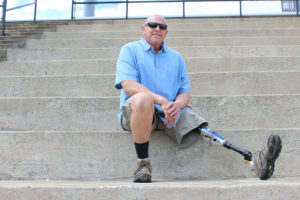Bringing In The New
 Bringing in the new – a woman's story of getting the prosthetic leg she wanted
Bringing in the new – a woman's story of getting the prosthetic leg she wanted
Jane (not her real name) is a strong woman who will fight for what she wants.
Growing up and living with the challenges of having a prosthetic leg, and other disabilities, she has had had a few obstacles to overcome in getting the right solution for her.
It’s been a rocky road for Jane – and not always a happy one. This is her story.
Living with disabilities right from the start
When Jane was born, in Kent, her mum spotted ‘something wrong’ with her leg right from the start, and this was just one of the issues she had to deal with.
“It’s a myriad of things,” Jane explains; “My thumbs weren’t right, I had a lazy eye, I’m a bit deaf and of course there was the leg. My left femur was shorter, which meant I had a shorter leg – and it was putting pressure on my hip, which didn’t really work.”
Growing up, Jane wasn’t really aware of what her disabilities meant. She was bullied at school and went through numerous operations at Great Ormond Street; but it wasn’t until she went on a holiday for thalidomiders, when she was 16, that it really hit home.
“I spent the whole fortnight crying” she remembers “I kept asking ‘how could this happen to these lovely people?’ – I was crying for them; not me.”
Jane had wanted to be a social worker from the age of 11 and, despite a child psychologist suggesting her future lay in a ‘nice secretarial job’, and the lack of understanding of her teachers, she did just that and spent 30 years working as a social worker in Liverpool.
Jane's determination drove her to seek help with her leg pain
In constant pain with her legs, Jane had an abscess the size of a tennis ball and numerous other abscesses which wouldn’t drain. She sought the help of the Thalidomide Trust and was referred to Professor John Skinner, an expert in the field, by the Trust’s Director at the time, Martin Johnson.
“John was brilliant” she explains “but the hospital staff were not. The nurse was rude and did nothing to protect my dignity, leaving doors open when I was undressed and talking to me as if I was a subordinate in the army! I ended up meeting her a few times – and it was always the same. I had already been bullied both at school and in the work place, so I wasn’t taking any nonsense.”
Despite receiving poor care from some, Jane persevered with her consultant, John
Over the next five years, Jane, was not the model patient. She distrusted hospitals and would never tell the real story, about the pain she was in, when John asked her how she was. In the end she saw him at Bolsover private hospital and he gradually got the truth out of her.
He told her it was time to get rid of her old leg – it weighed half a stone – and move on to something lighter.
“That was when my journey began” she explains.
“Professor John wrote to the limb centre but the manager was not very helpful and kept changing his mind. I knew what I wanted and my fitter, Karen, knew what I needed but he just kept telling John we couldn’t afford it. To me it was essential that my leg looked like a proper leg, whatever the cost. I had to take someone with me to the consultations as I was frightened that I was going to lose it! I was so angry.”
Jane turned to the Trust who gave her vital support
“I couldn’t have got any further without the assistance of Dr Dee Morrison and Katy Sagoe,” she explains “Dee really helped me sort the problem out. She suggested that there might be some exceptional funding available from the Trust, as the NHS were not able to fund the kind of limb I needed.
When I arrived at the Trust to talk things through, I met Katy, the Director of Health and Wellbeing who explained that there might be some funding available from the original maker of thalidomide, the German company Grünenthal, through their Charitable Foundation.”
“A lot of politics surround Grünenthal , for obvious reasons” Jane explains.“They went to criminal trial in 1968 for their part in the thalidomide disaster, and, in the early days, employed a number of medics who were part of the Nazis’ eugenics team.
Grünenthal is still in existence today, and make grants available in ‘exceptional circumstances’ through their charitable Trust. Quite ironic when you think about how exceptional thalidomide damage is. Every thalidomider should have the opportunity to live the best possible life they can. It makes me sad, and angry that we have to fight for what we need.
It was a very emotional decision for me to apply for the grant as my father served in World War two, against the Nazi regime, and it also felt like a bribe to take the money. Making up my mind caused me a lot of emotional distress, and the Trust was there for me.”
It took Jane a lot of sleepless nights and painful soul-searching to make her decision. Once it was made, Jane went to Dorset Orthopaedics for her leg.
Rehabilitation is key to making a prosthetic leg work well for you
“It was amazing how the technology has moved on, and my leg was incredible,” she says.
“It wasn’t just about having the new leg, though. Rehabilitation is vital in making it work well for you, so it’s very important to sign up for that – it’s all part of getting the leg and using it well.”
“They gave me a great physio, Beth, who works with the England football team,” says Jane. “She told me the leg had made my whole body out of sync and that I would have to learn to walk again in a whole new way. I had to sign up for rehab to learn to use the new leg which has a spring in it. It’s as much about the brain as it is about the body.”
Living life to the full
Jane is now using her new leg and will have another one made so that she can alternate them.
She swims and walks and is living her life to the full, including wearing sandals and shorts in summer, something she thought she would never do.
Despite her gruelling journey, Jane feels she now has the leg she always should have had.”My advice would be to make full use of this great new technology if you can” she says emphatically. “Find out more about the Grünenthal Foundation’s funding and go for it. The Trust will provide a letter of support if you need it. Not everyone gets funding, but it’s definitely worth a try.”
Find out more about prosthetics

Read more beneficiary stories about prosthetics

